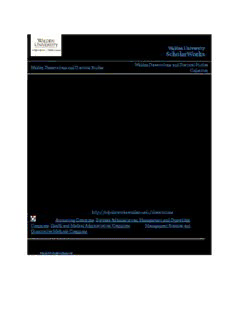
Collaborative Strategies Used to Reduce Billing Administrative Cost PDF
Preview Collaborative Strategies Used to Reduce Billing Administrative Cost
Walden University ScholarWorks Walden Dissertations and Doctoral Studies Walden Dissertations and Doctoral Studies Collection 2017 Collaborative Strategies Used to Reduce Billing Administrative Cost Stella Fayomi-Olaleye Walden University Follow this and additional works at:https://scholarworks.waldenu.edu/dissertations Part of theAccounting Commons,Business Administration, Management, and Operations Commons,Health and Medical Administration Commons, and theManagement Sciences and Quantitative Methods Commons This Dissertation is brought to you for free and open access by the Walden Dissertations and Doctoral Studies Collection at ScholarWorks. It has been accepted for inclusion in Walden Dissertations and Doctoral Studies by an authorized administrator of ScholarWorks. For more information, please [email protected]. Walden University College of Management and Technology This is to certify that the doctoral study by Stella Fayomi-Olaleye has been found to be complete and satisfactory in all respects, and that any and all revisions required by the review committee have been made. Review Committee Dr. Edward Paluch, Committee Chairperson, Doctor of Business Administration Faculty Dr. Lynn Szostek, Committee Member, Doctor of Business Administration Faculty Dr. Julia East, University Reviewer, Doctor of Business Administration Faculty Chief Academic Officer Eric Riedel, Ph.D. Walden University 2017 Abstract Collaborative Strategies Used to Reduce Billing Administrative Cost by Stella Fayomi-Olaleye MBA, American InterContinental University, 2007 BS, State University of New York, College at Buffalo, 2000 Doctoral Study Submitted in Partial Fulfillment of the Requirements for the Degree of Doctor of Business Administration Walden University December 2017 Abstract Billing inefficiencies represent 80% of wasteful healthcare administrative costs that are projected to reach $45 billion by 2018. Potentially, a reduced billing administrative cost is estimated to yield an annual savings of $60 billion that could fund other societal needs such as jobs, wage increases, and education. Through the conceptual framework of iceberg change management model, this single case study explored collaborative strategies 3 healthcare billing managers in Dallas, Texas successfully used to reduce billing administrative costs. Data were collected through semistructured interviews and the review of company documents. Using Yin’s procedure of examining, comparing, categorizing, and coding data, the thematic analysis exposed 5 themes: task coordination, communication, stakeholder involvement, relationship management, and performance indicators. The findings indicated that collaborative strategies might serve as a guideline for billing managers to identify and manage behaviors, attitudes, and processes that hinders the reduction of wasteful billing administrative costs. The implication for positive social change is the potential to reduce the number of individuals who forgo care due to medical billing complexities and disputes. The study may also contribute to social change by providing other billing managers and administrators with strategies for reducing healthcare billing administrative costs. Potential cost savings derived from improved billing administrative costs could fund healthcare for the uninsured and underinsured. The implementation of these collaborative strategies may improve fragmented billing processes, resulting in reduction of wasteful healthcare spending. Collaborative Strategies Used to Reduce Billing Administrative Cost by Stella Fayomi-Olaleye MBA, American InterContinental University, 2007 BS, State University of New York, College at Buffalo, 2000 Doctoral Study Submitted in Partial Fulfillment of the Requirements for the Degree of Doctor of Business Administration Walden University December 2017 Dedication I dedicate this accomplishment to my Lord and Savior Jesus Christ, who never forsook me even when all odds were against me. My husband believed in me and encouraged me daily with endless love and sacrifice. My beloved children recognized the principle of working hard and not giving up at a very young age and understood why I had to spend uncountable hours in my study closet. My parents whose uncountable sacrifices propelled me to accomplish my goals. Acknowledgments I am thankful to my second chair Dr. Lynn Szostek, URR Dr. Julia East, and CAO Reviewer Dr. Matthew Jones for their boundless support throughout the process. I am grateful for my committee chair Dr. Edward Paluch, whose eagerness to get me to the finished line never ceased. I appreciate all the time you spent reviewing my work and responding to my emails and texts. The numerous sacrifice of time you spent listening, coaching, and directing led me to the finish line! Table of Contents Section 1: Foundation of the Study ......................................................................................1 Background of the Problem ...........................................................................................1 Problem Statement .........................................................................................................2 Purpose Statement ..........................................................................................................2 Nature of the Study ........................................................................................................3 Research Question .........................................................................................................4 Interview Questions .......................................................................................................4 Conceptual Framework ..................................................................................................5 Operational Definitions ..................................................................................................6 Assumptions, Limitations, and Delimitations ................................................................7 Assumptions ............................................................................................................ 7 Limitations .............................................................................................................. 7 Delimitations ........................................................................................................... 7 Significance of the Study ...............................................................................................8 Contribution to Business Practice ........................................................................... 8 Implications for Social Change ............................................................................... 8 A Review of the Professional and Academic Literature ................................................9 Organization of Literature Review ......................................................................... 9 Iceberg Change Management Model .................................................................... 10 Collaboration and Change Management ............................................................... 12 Collaborative Change Management Theories ....................................................... 14 i Collaborative Change Management Style ............................................................ 19 Multipayer Healthcare Billing System.................................................................. 25 Billing Administrative Costs ................................................................................ 31 Transition .....................................................................................................................37 Section 2: The Project ........................................................................................................38 Purpose Statement ........................................................................................................38 Role of the Researcher .................................................................................................39 Participants ...................................................................................................................41 Research Method and Design ......................................................................................42 Research Method .................................................................................................. 42 Research Design.................................................................................................... 44 Population and Sampling .............................................................................................45 Sampling Method .................................................................................................. 46 Participant Eligibility Criteria ............................................................................... 46 Interview Process .................................................................................................. 47 Ethical Research...........................................................................................................48 Data Collection Instruments ........................................................................................51 Data Collection Technique ..........................................................................................52 Data Organization Technique ......................................................................................56 Data Analysis ...............................................................................................................57 Reliability and Validity ................................................................................................59 Reliability .............................................................................................................. 59 ii Validity ................................................................................................................. 60 Transition and Summary ..............................................................................................63 Section 3: Application to Professional Practice and Implications for Change ..................64 Introduction ..................................................................................................................64 Presentation of the Research Findings .........................................................................64 Coordination of Interrelated Tasks ....................................................................... 65 Communication ..................................................................................................... 70 Stakeholders’ Involvement ................................................................................... 71 Relationship Management .................................................................................... 74 Performance Indicators ......................................................................................... 77 Relation of Findings to the Iceberg Change Management Model ........................ 79 Applications to Professional Practice ..........................................................................82 Implications for Social Change ....................................................................................85 Recommendations for Action ......................................................................................86 Recommendations for Further Research ......................................................................88 Reflections ...................................................................................................................88 Conclusion ...................................................................................................................90 Appendix A: Letter of Intent............................................................................................129 Appendix B: Follow up Reminder ...................................................................................130 Appendix C: Interview Protocol ......................................................................................131 Appendix D: Interview Questions ...................................................................................133 iii
Description: